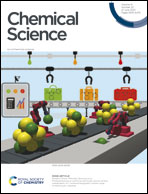Tracking C–H bond activation for propane dehydrogenation over transition metal catalysts: work function shines†
Abstract
The activation of the C–H bond in heterogeneous catalysis plays a privileged role in converting light alkanes into commodity chemicals with a higher value. In contrast to traditional trial-and-error approaches, developing predictive descriptors via theoretical calculations can accelerate the process of catalyst design. Using density functional theory (DFT) calculations, this work describes tracking C–H bond activation of propane over transition metal catalysts, which is highly dependent on the electronic environment of catalytic sites. Furthermore, we reveal that the occupancy of the antibonding state for metal–adsorbate interaction is the key factor in determining the ability to activate the C–H bond. Among 10 frequently used electronic features, the work function (W) exhibits a strong negative correlation with C–H activation energies. We demonstrate that e−W can effectively quantify the ability of C–H bond activation, surpassing the predictive capacity of the d-band center. The C–H activation temperatures of the synthesized catalysts also confirm the effectiveness of this descriptor. Apart from propane, e−W applies to other reactants like methane.



 Please wait while we load your content...
Please wait while we load your content...